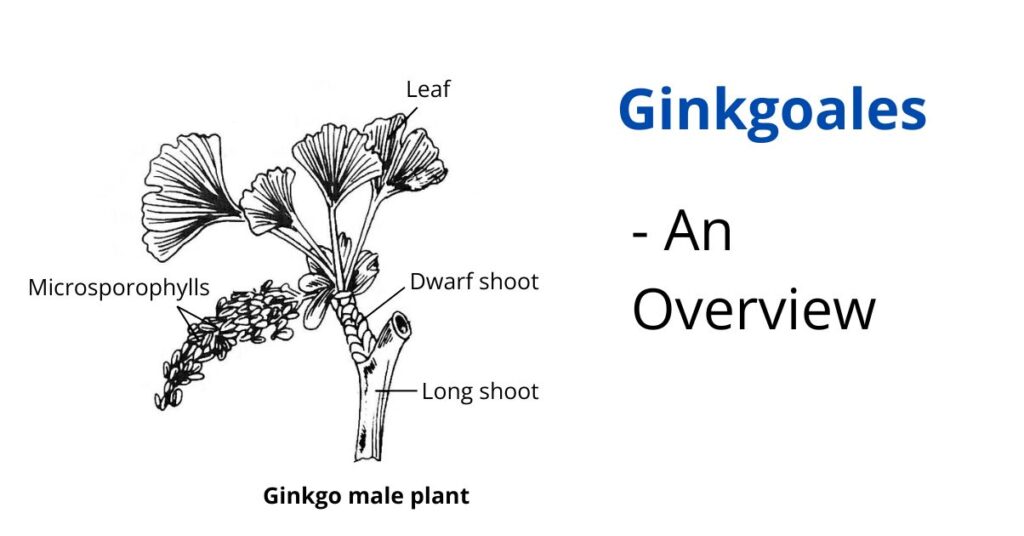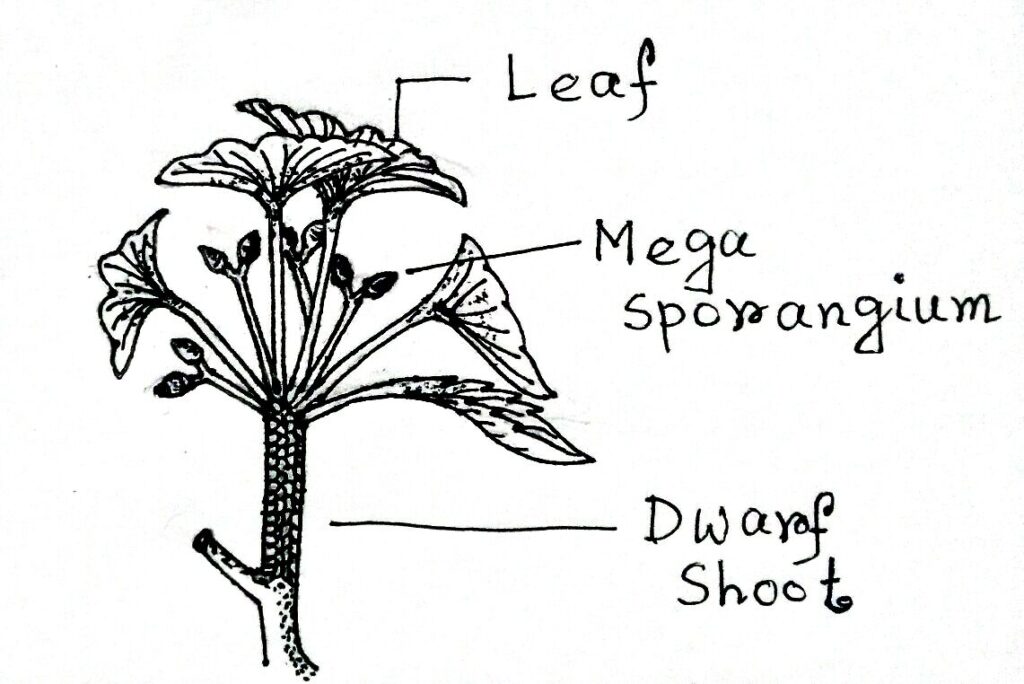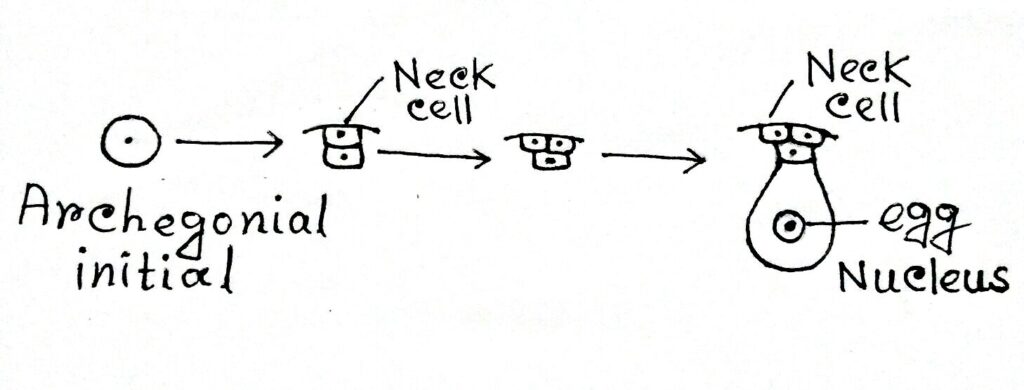Ginkgoales is a gymnospermic order having one living genus (Ginkgo biloba). The members of this order once had an almost worldwide distribution in the Jurassic period. The fossil members of this order probably appeared in the Devonian period of the Paleozoic era, began to expand in the Triassic period, and reached their climax in the Jurassic period of the Mesozoic era, after which they began to decline. Mainly, in this order, 16 genera have been classified, out of which 15 genera are now extinct.
The order Ginkgoales contains only one family Ginkgoaceae which includes one genus Ginkgo biloba. Due to the presence of primitive characters, it (Ginkgo biloba) is also known as a living fossil. This order is characterized by medium-sized dioecious trees with tall and branched stems. Leaves are flattened, variously lobed, and with dichotomous venation.

Distribution of Ginkgoales
- Ginkgo biloba originated in the Triassic period and is present even today.
- It is mainly distributed in South-eastern China and Japan.
- In India, this plant is found as a cultivated ornamental plant in the hills (Darjeeling, Mussoorie, Dehra-Dun).
- Example: Ginkgoales consists of only one living genus Ginkgo biloba.
Morphology of Ginkgoales
External Morphology
Stem
- Stem is long, woody, erect, and branched.
- The plant inhabits looks like a conifer and attains a height of 27-30 meters. It has long and dwarf shoots. Long shoot arises from the main stem and it shows higher growth.
- The leaves are green and are spirally arranged.
- Dwarf shoot arises from foliage leaf and shows slow growth. It bears branches, leaves, and reproductive organs.
- The long shoot is modified into a dwarf shoot if its apical bud is removed.
Leaves
- The leaf is very characteristic in form and in venation, which is large and fan-shaped.
- It is petiolate, bilobed, and bent.
- Initially, the leaves are yellowish-green and later turn dark green.
- Venation is an open dichotomous type and leaves are deciduous.
Root
- In Ginkgo, the root is a long taproot that penetrates deep into the soil.
- Root hairs are present in the taproot.
Internal Morphology
Stem Anatomy
- The outermost layer is the epidermis, which is covered by cuticles.
- It is followed by the parenchymatous cortex.
- The cortex possesses resin canals and crystals of calcium oxalate.
- Endodermis and pericycle are not distinct.
- The young stem has many primary vascular bundles arranged in a ring. These are conjoint, collateral, and open.
- Due to secondary growth, leaf traces are present.
- The ring of endarch vascular strands forms a siphonostelic cylinder.
- Medullary rays are uniseriate.
- The protoxylem has spiral thickening and the metaxylem has bordered pits.
- The phloem is made up of sieve tubes.
- The pith is large and parenchymatous. It has a mucilage canal.
Leaves Anatomy
- The epidermis is covered by a thick layer of cuticle.
- Cells are polygonal and stomata are haplochelic. Guard cells are surrounded by subsidiary cells.
- Spongy type mesophyll tissue has a mucilage cavity.
- Vascular bundles are surrounded by bundle sheaths.
Internal Structure of Root
- The root possesses radial vascular bundles and they are diarch.
- A large cortex, endodermis, and a pericycle are found just outside of the stele.
- Mucilage canals, tannins, and starch occur in the parenchymatous cells of the cortex.
Secondary growth
- Wood is picnoxylic and monoxylic. Wood is not used due to its brittle nature.
- Tracheids have uniseriate and multiseriate bordered pits.
- Due to secondary growth, the cortex is changed to a periderm.
- In primary wood, Bars of Sanio are not present.
Reproduction of Ginkgoales
Ginkgo biloba is monosporangiate and strictly dioecious. Male and female strobili occur on male and female plants respectively.
Staminate Strobilus
- The male strobilus is present at the terminal end of a dwarf shoot on the male plant.
- They arise in the axils of foliage leaves or inner bud scales.
- It consists of a central axis upon which microsporophylls are arranged spirally.
- Each microsporophyll has 2-4 microsporangia.
- The development of microsporangia takes place through a single initial cell. It divides and forms primary wall cells and primary sporogenous cells.
- Now it shows periclinal division forming wall layer and sporogenous tissues.
- These sporogenous tissues divide and form tapetum and spore mother cells.
- In mature sporangium, many-layered wall, tapetum, and spore mother cells are present.
- Spore mother cells form microspores (pollen grains).

Ovulate Strobilus
- Female strobilus originates on a dwarf shoot of the female plant.
- It is present on the axis of scale leaves.
- A strobilus consists of a long and slender stalk (peduncle), which has 2-3 ovules.
- The upper part of the stalk is bifurcated.
- Only one ovule is matured, the rest of all disintegrate.
- Vascular traces are 3-6 in number. Ovules are formed in April and are surrounded by a single integument.
- In nucellus, a single megaspore mother cell is present.
- A large pollen chamber is present at the apex of the nucellus.
- The integument at the upper end forms a nucellar beak.
- The integument has a megaspore mother cell that undergoes meiosis and forms 4 megaspores.
- Only the lowermost one becomes a functional megaspore and the other tree degenerates.
Gametophytes of Ginkgoales
Male Gametophyte
- The first cell of the gametophyte is a microspore having both exine and intine layers.
- The exine is incomplete and develops in sporangium.
- Due to its division, prothallial cells are formed which further divide and form a secondary prothallial cell and an antheridial cell.
- The antheridial cell further divides to form a generative cell and a tube cell.
- The intine of the pollen grain protrudes out to form a pollen tube which acts as haustoria.
- The pollen tube moves towards the female gametophyte.
- On its way, the pollen tube absorbs the tissue of the female gametophyte.
- The generative cell finally divides into a stalk cell and a body cell.
- The body cell increases in size before its division and two blepharoplasts make their appearance at the two poles of the nucleus.
- The body cell next divides to form two sperms or male gametes which are multiciliate and form a long tube.

Female Gametophyte
- Megaspore is the first cell of the female gametophyte.
- During gametophyte formation, it increases in size and its nucleus divides freely to form a large number of free nuclei.
- Cell wall formation next starts at the periphery and then proceeds towards the center and thereby a spongy nutritive tissue (endosperm) is formed.
- The endosperm is green in color.
- In addition to the megaspore membrane, the gametophyte becomes covered by another thin membrane.
- Two or three archegonia are formed at the upper end of the gametophyte from the archegonial initial.
- The archegonium consists of a two-celled neck, a ventral canal cell, and an egg.

Fertilization
- The ventral canal cell of female gametophyte disappears during fertilization and the pollen tube enters the archegonium.
- Now cilia add no cytoplasmic membrane gets removed.
- Male nuclei shift towards female nuclei. Both nuclei fuse to form the diploid zygote.
Embryo Development of Ginkgoales
- In the zygote, free nuclear division occurs and 256 cells are formed. Although the central vacuole is not formed.
- It enlarges at the micropylar end and forms a suspensor.
- In a developed embryo, two cotyledons and a shoot apex are present.
Seed Germination
- The seed normally possesses one embryo.
- It is large and is protected by a distinct three-layered seed coat (tests) formed from the ovular integument.
- The outermost layer of the seed coat is fleshy, the middle layer is hard and stony.
- The innermost turns into a thin fleshy layer.
- The germination of the seed is hypogeal, which finally gives rise to a new Ginkgo plant.
Classification of Ginkgoales
K. R. Sporne (1965) classified order Ginkgoales into mainly two families:
- Trichopityaceae
- Ginkgoaceae
